AIA
Home Design Trends Survey
Neighborhood and Community Design Moves Toward Accessibility, Simplicity
Housing downturn puts premium on infill and higher-density locations
by Kermit Baker, PhD, Hon. AIA
AIA Chief Economist
Summary: The
continued weakness in the residential market is changing how communities
and neighborhoods are being designed. There is greater emphasis at
present on integrating homes with activities such as public transportation
and commercial and recreational uses. This in turn has generated
greater density in developments, with infill locations viewed as
popular according to results from the AIA Home Design Trends Survey
for the third quarter of 2009.
Home exteriors are generally simpler, given the attention to affordability
in this economic environment. They increasingly emphasize low maintenance,
durability, and sustainability while, given the denser locations,
porches and other features that encourage neighborhood interaction
also are increasing in popularity.
Business conditions for residential architects remain weak. In the
third quarter, billings on existing projects as well as inquiries
for new projects both stalled at second quarter levels, whereas in
previous quarters these indicators had shown signs of improvement.
Residential architects in the Northeast and West are reporting somewhat
more encouraging conditions than are those in other regions. Affordable
homes for first-time buyers—the first sector to head down when
the housing recession began—appear to be poised for a recovery,
helped in large part by the federal tax credit for first-time homebuyers.
Remodeling activity was reported to strengthen during the quarter.
Neighborhood design trends reflect greater integration into the
community
The national housing downturn has produced unusually high inventories
of unsold homes in urban fringe locations. These were the locations
where large enough parcels of land could be assembled to generate
the volume of construction required during the housing boom earlier
this decade. However, when the housing market weakened, large inventories
of unsold homes remained on the market in these locations.
Rising home energy costs prior to this downturn have helped to generate
interest in smaller, more energy efficient homes in locations that
were accessible to transportation, commercial activities, and jobs.
This trend has generated demand for homes in locations closer to
urban centers. As a result, community and neighborhood design priorities
have been shifting. Infill development, with smaller parcels in more
developed areas, has become very attractive according to residential
architects that participate in this quarterly survey. These infill
sites typically have higher densities than exurban locations and
generally are more accessible to public transportation opportunities
and may be part of mixed-use projects (e.g. residential/retail or
residential/recreational) that integrate a wider variety of activities.

Given the growing interest for greater densities in housing options
located in infill locations, emerging home styles promote greater
neighborhood interaction. Greater use of front and side porches is
mentioned as a trend growing in popularity by a majority of residential
architects. Single-story homes also are becoming more popular, reflecting
lower construction costs in most areas as well as the growing trend
toward accessibility through the home for an aging population. A
growing share of residential architects also report simpler detailing
on home exteriors, again reflecting the need to keep home designs
affordable.
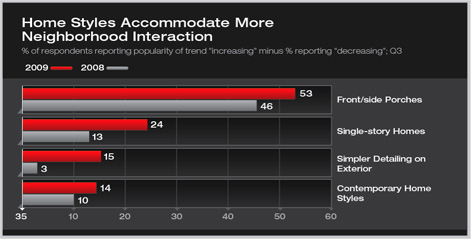
Even with the focus on housing affordability during this downturn,
residential architects report significant interest in low-maintenance
and green products for home exteriors. Three-quarters of respondents
reported growing interest in low-maintenance exterior materials (e.g.,
fiber-cement board and stone) while a majority indicated that consumer
interest in sustainable roofing materials was increasing. Two specific
green exterior products that hadn’t been included in previous
surveys—tubular skylights and green roofs—also were seen
by a sizeable share of residential architects as increasing in popularity,
although apparently off of a fairly small base of consumers that
have undertaken these projects to date.
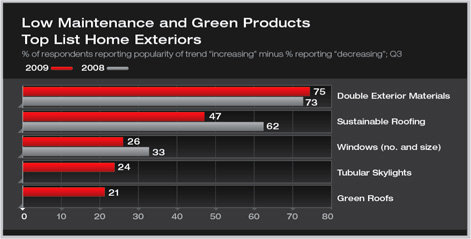
Business conditions remain weak
In spite of some emerging signs of improvement in the broader residential
markets, business conditions remain very weak for residential architects.
The index for billings at these firms rose sharply from 20 in the
fourth quarter of 2008 to 38 in the second quarter of 2009. However,
the third quarter figure showed no improvement, and a score of
38 on this index indicates that many more firms are reporting declining
billings than are reporting increases in business activity.
Inquiries for new projects are showing a similar pattern, although
the index scores are higher. Inquiries also have climbed dramatically
since a low in the fourth quarter of 2008 but also leveled off with
the third quarter reading with an index score of 47. Inquiries therefore
are seeing much slower levels of declines than are billings, but
have not yet recovered from their recessionary levels.
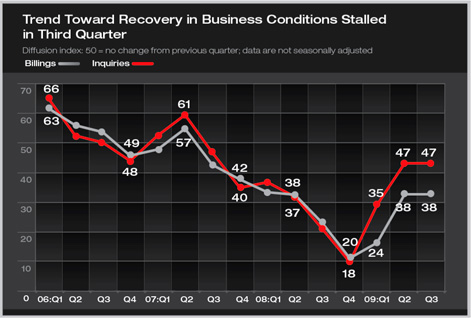
Evidence of continued weak conditions in the profession can be seen
in the levels of backlogs at these firms. Backlogs—the amount
of work currently in-house compared to the amount needed to keep
staff fully employed—have been steadily declining. They reached
a low of 2.8 months in the first quarter of this year and have barely
budged from this level since.
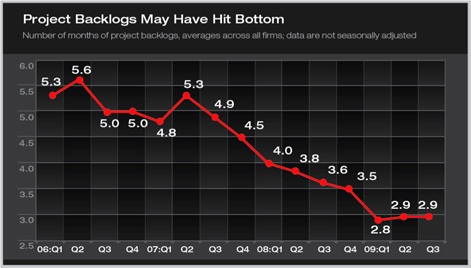
Regional billings activity also has been moving in the right direction,
but firms in all regions of the country are still reporting declines
in revenue levels. The highest index scores are for firms in the
Northeast and Midwest, while the largest gains in index scores are
at firms in the South and West as the housing market begins to recover
in these Sunbelt locations. Still, the third quarter figures don’t
indicate an imminent recovery for firms in any parts of the country.
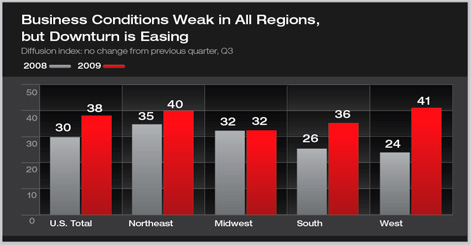
Recovery beginning at the bottom of the housing market
Since residential architects are involved in a broad range of home
design activities, they are in a unique position to compare the
health of different sectors of the housing market. A year ago,
they indicated that the affordable market for first-time buyers
and the trade-up market for households moving to mid-level homes
were among the weakest sectors in the industry. However, falling
house prices over the past year, mortgage rates that have remained
favorable, and the federal government’s tax credit for first-time
homebuyers have all helped shore up the lower end of the housing
market. Currently, these two sectors look to be the closest to
recovery.
The weakest sector at present is the second and vacation home market,
which was also the weakest a year ago. Many households looked to
second and vacation homes as investments, hoping to realize some
appreciation in these properties. With the decline in house prices
nationally, these properties are much less attractive at present.
Home improvement activity has remained much more stable during this
downturn, and many residential architects indicate that kitchen and
bath remodeling, as well as additions and alterations to existing
homes, have increased over the past year. As this housing recovery
continues to unfold, we can expect to see the strength in improvements
to existing homes as well as in lower-priced homes.
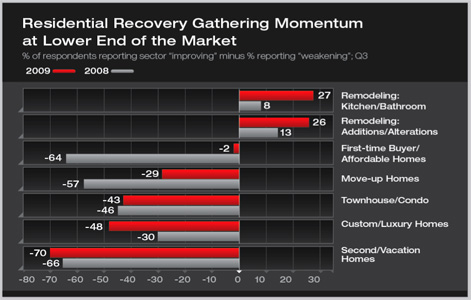
|








